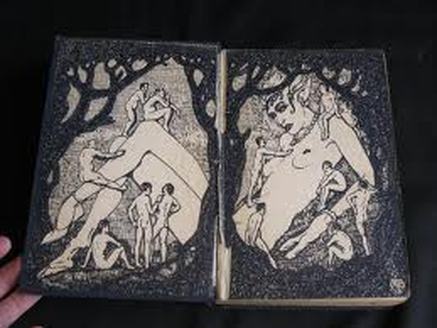
Frontispiece for Thirteen Men. Presumably, the men are the jurors, and the naked woman is lady justice. Thayer had a puerile sense of humor.
Read Thayer's Thirteen Men. It's a book in fourteen chapters--the first details a series of murders, all committed by the same man, but for no known reason, and his capture. Each of the next twelve covers the lie of one juror, from birth to the moment he is called upon to do his duty. The final chapter examines the killer's motives.
As is obvious from the description, there is only a thin tissue holding together the various stories--which seems to be part of Thayer's point. He enjoys being the omniscient narrator and noting the coincidences in the various lives--but to no greater effect than to note them. The stories themselves are sometimes empathetic and insightful, more often playing with stereotypes--not necessarily justifying them--and hinting at salacious details.
The Fortean connection is not revealed until the final chapter, when the killer speaks. He is an egoist, who killed the various people largely because he could. And he cites Fort as helping to develop his philosophy, although he does not spell out the connection.
As is obvious from the description, there is only a thin tissue holding together the various stories--which seems to be part of Thayer's point. He enjoys being the omniscient narrator and noting the coincidences in the various lives--but to no greater effect than to note them. The stories themselves are sometimes empathetic and insightful, more often playing with stereotypes--not necessarily justifying them--and hinting at salacious details.
The Fortean connection is not revealed until the final chapter, when the killer speaks. He is an egoist, who killed the various people largely because he could. And he cites Fort as helping to develop his philosophy, although he does not spell out the connection.
